The first fresh spring breeze tickling your skin after a light drizzle. The smell of petrichor. A cool gentle wind flowing through your window on a warm summer night. I may have taken these things for granted before embarking on my way around the world.

Not long into my time living in Hà Nội, I had a nightmare.
I’m not sure exactly where I was. The room I inhabited was long; oblong or rectangular in shape. There were long windows along the top quarter or so of one of the long walls. They were high enough that it was necessary to stand on something, like a bed or a stool, to see completely outside.
The exit to the room was a door in a corner on the opposite wall facing the windows.
I climbed up and looked through the windows. It was night. There was a highway that was jam-packed with vehicles not unlike travel during the holidays when most people are rushing home to reunite with their families. There was a feeling of urgency.
But people were not rushing home for festivities.

People were rushing to their bunkers. I was in a bunker! And we were running out of time. Soon, the Earth was going to run out of oxygen. It would no longer be possible to breathe outside. We would have to rely on our oxygen supply within our bunkers. It would be like living in a submarine or on the Moon.
All of the windows were reinforced and sealed, but could be opened mechanically before the dreaded moment.
I was scared. I needed to be able to go outside and breathe and feel the sun and wind. How did this happen!?
Time passed and I looked through the windows again. It was day now and the traffic jam of civilian vehicles had been replaced with lines of military ones, including tanks.
I watched the military convoys and thought they would probably be the only ones capable of successful travel outside from now on. In that moment, I noticed something out of the corner of my eye. One of the windows was cracked open.
I went to the window and tried to close it. It didn’t budge. There was a countdown somewhere marking how much time was left before oxygen ran out. Terror rose in my throat. I kept pushing and pushing against the window. What would happen if I couldn’t get it closed? How would we breathe?
Then I woke up.
I don’t know if I managed to get the window closed. I know I was cutting it damned close.
I was relieved it had only been a dream.
However, it wouldn’t be long before I’d again see numbers like these on one of my air quality mobile apps:
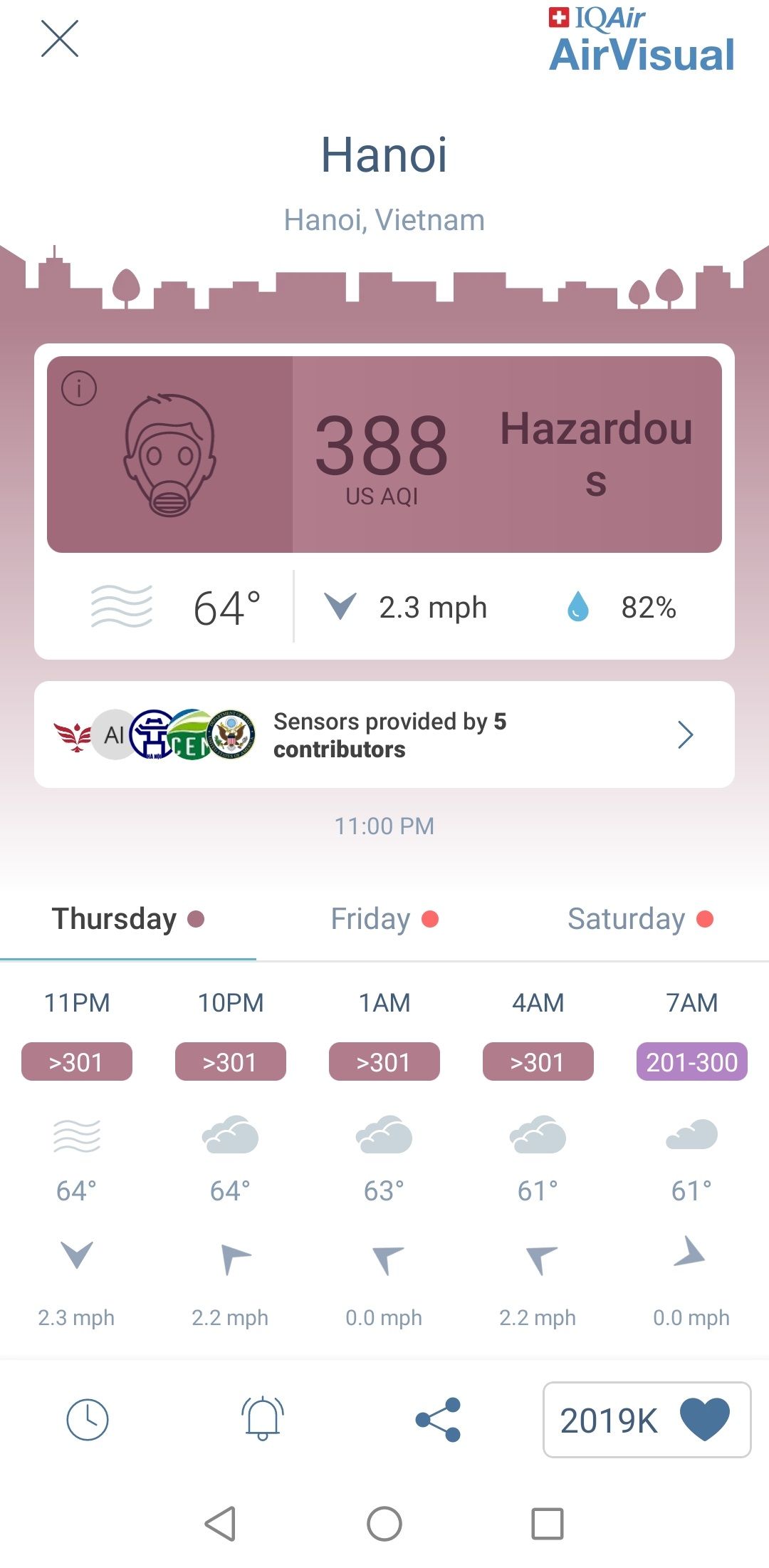
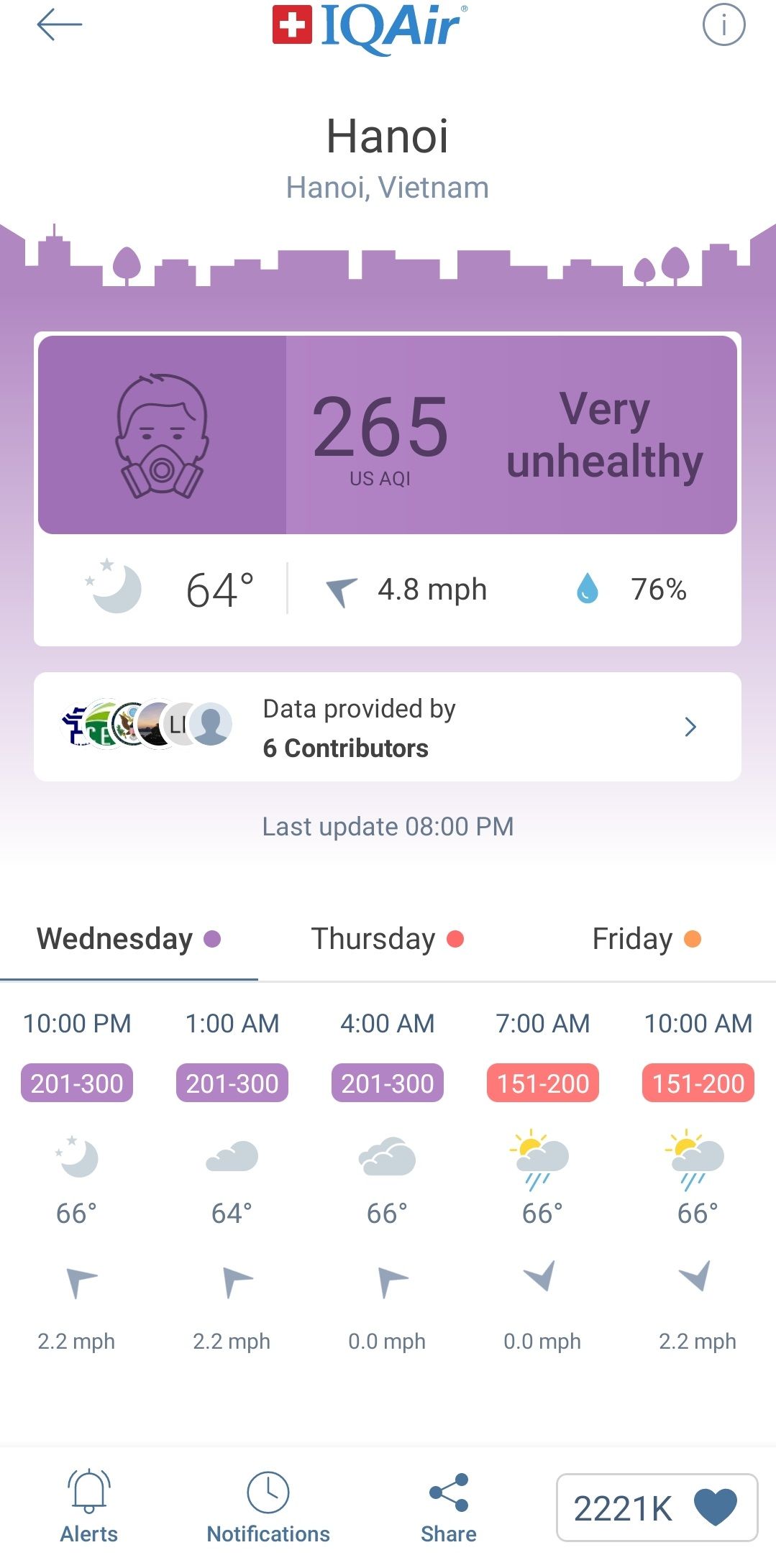
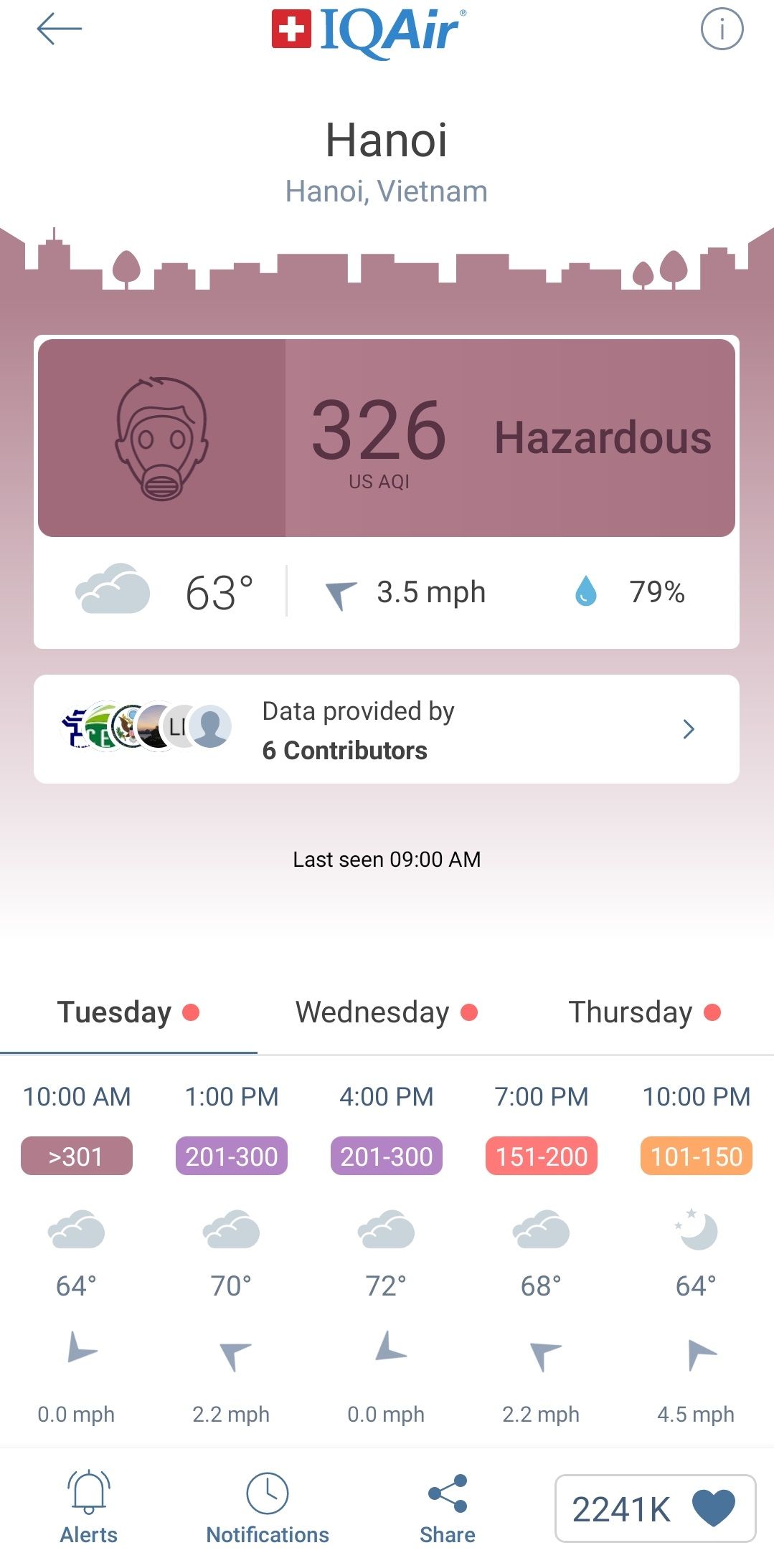
I’ve always had vivid dreams and I’m an avid fantasy and science fiction enthusiast.
But would I have dreamt this scenario before my time in Hà Nội?
I don’t think so.
With the exception of seasonal spring allergies, breathing has generally been easy for me. At some point I realized annual allergies weren't a given but in fact were linked to my location. Away at university I had nary a sniffle or itchy eye in the spring, unlike back home. Then, one late summer, during my first visit to the state fair, allergies hit like a ton of bricks complete with sneezing fits that lasted days. I'd never experienced allergies at that time of the year before.
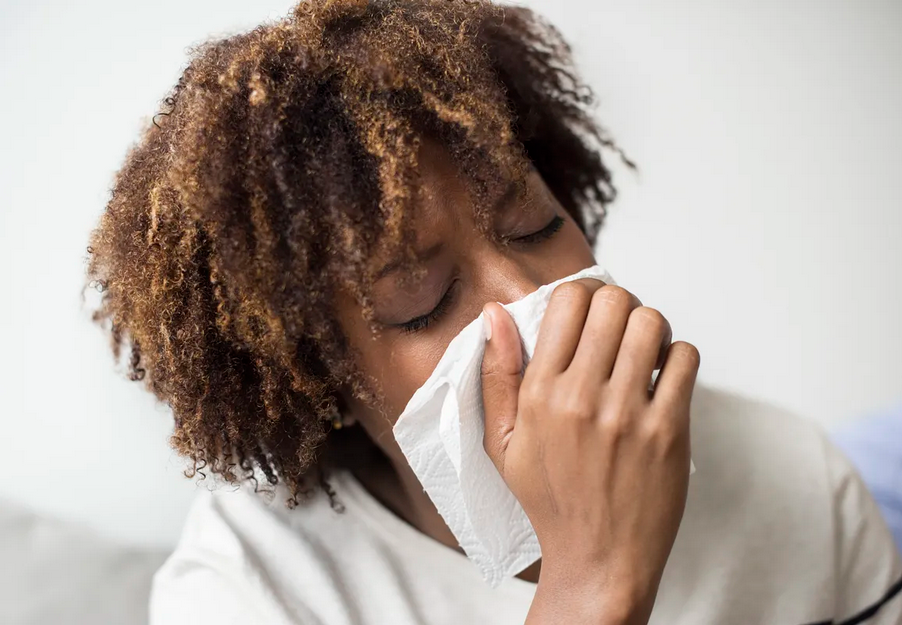
I had an immediate physiological response to the air quality in Hà Nội.
Symptoms include excessive sneezing and congestion similar to my reaction during pollen and allergy season (allergic rhinitis). A lingering plugged ear and earache developed. Health checks reflected an affected eardrum and elevated blood pressure which I never experienced before. Lack of sun due to continuous polluted unclear days has a depressing effect. Keeping windows closed due to lack of fresh clean air has a claustrophobic effect.
While I thought I’d prepared for the air quality problem by bringing a supply of N95 masks with me to Hà Nội, I had not anticipated exposure to outside poor air quality while indoors. Some of these problems were alleviated by moving to a different apartment and buying an air purifier. Some problems were only addressed by moving to a less polluted locale.

What Is Air Pollution?
Odds are if you’re a millennial from North America, Europe or Australia, the words “air pollution” brings thoughts of holes in the ozone layer, forest fires, and the days of cars and buses spewing noxious brown clouds in 90s. I haven’t used an aerosol hair spray and air “freshener” since that decade either.
National Geographic has this to say:
Air pollution consists of chemicals or particles in the air that can harm the health of humans, animals, and plants. It also damages buildings. Pollutants in the air take many forms. They can be gases, solid particles, or liquid droplets.
Further information:
- Criteria Air Pollutants | US EPA
- Types of air pollutants | British Lung Foundation
- Outdoor air pollution and the lungs - European Lung Foundation
Air Pollutant Types and Their Effects on Health
Particulate Matter
Particulate Matter (PM), also called particle pollution, is a mixture of solid particles and liquid droplets found in the air. This mixture varies in size and composition. Some particles, such as dust, dirt, soot, or smoke, are large or dark enough to be seen with the naked eye while others can only be seen with an electron microscope.
- PM10 are coarse inhalable particles that are generally 10 micrometers (μm) and smaller.
- PM2.5 are fine inhalable particles that are generally 2.5 micrometers (μm) and smaller.
- Ultrafine particles (UFP) are generally 0.1 micrometers (μm) and smaller.
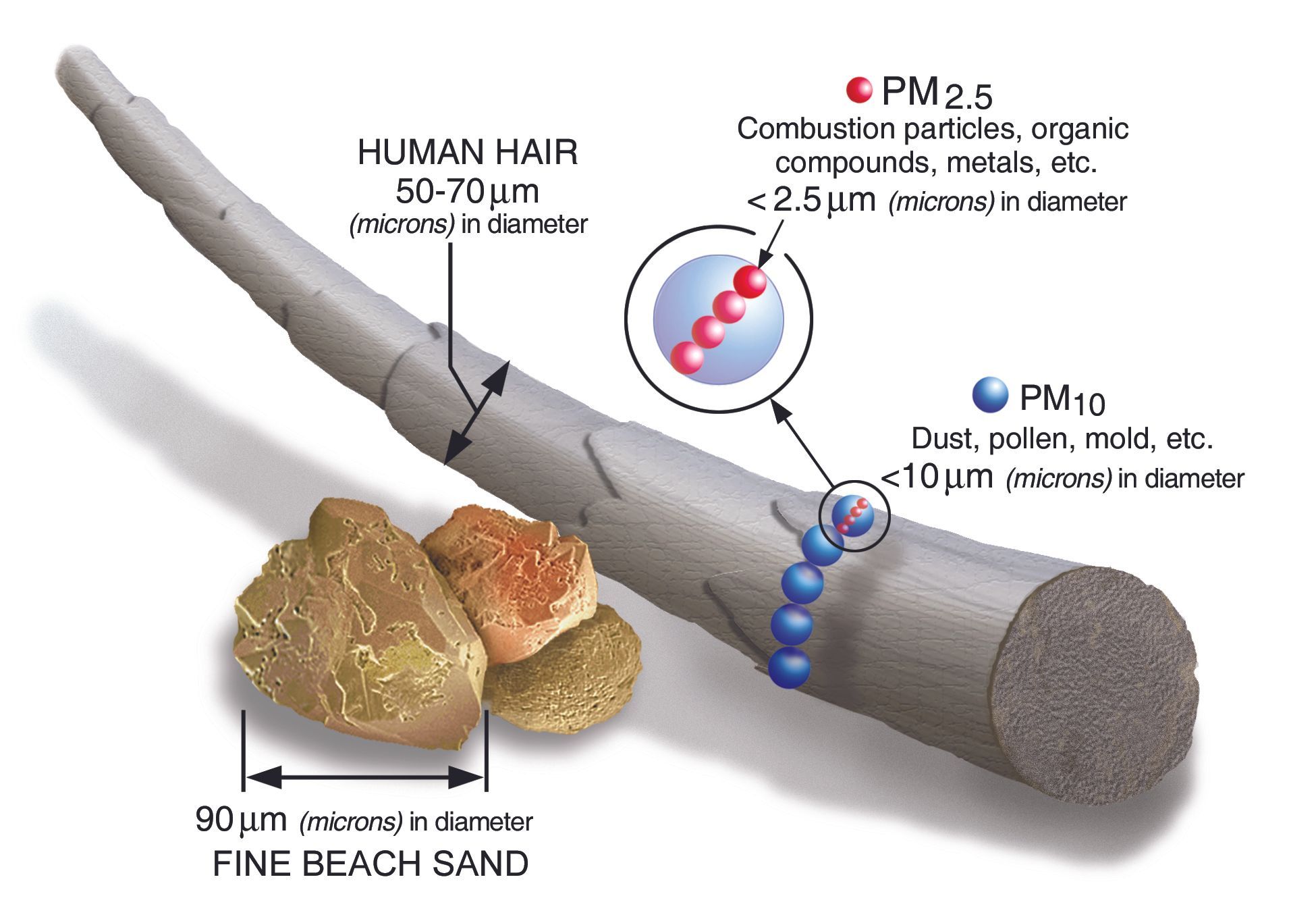
The danger lies in the size of the particles. Particles 10 μm or larger may be caught in the nose and/or sneezed out of our bodies, however smaller particles bypass these defenses.
Airborne particulates are designated as a Group 1 Carcinogen by the International Agency for Research on Cancer (IARC) and World Health Organization (WHO). Particulates are the most harmful form (other than ultra-fines) of air pollution due to their ability to penetrate deep into the lungs, blood streams and brain, causing health problems including heart attacks, respiratory disease, and premature death.
References & Resources:
- Particulate Matter (PM) Pollution | US EPA
- Particle Pollution | American Lung Association
- Particulates - Wikipedia
- Ultrafine particle - Wikipedia
Ozone
Ozone (O₃), also called trioxygen, is a reactive colorless to blue gas with a pungent odor.
In the upper atmosphere (stratosphere), ozone is formed through the reaction of ultraviolet (UV) light with dioxygen (O2) creating the protective ozone layer.
In the lower atmosphere (troposphere), what is now ground-level ozone is formed through the reaction of sunlight and heat with volatile organic compounds (VOC) and nitrogen oxides (NOx) emitted by motor vehicles, power plants, chemical plants, refineries, factories, industrial furnaces, gas stations, auto-body shops, print shops, paint, and other sources.
Ozone is the chief component of smog or haze.
Exposure to ozone causes negative health reactions in people with AND without preexisting lung (pulmonary) diseases. These reactions may include:
- Coughing and sore or scratchy throat.
- Make it more difficult to breathe deeply and vigorously and cause pain when taking a deep breath.
- Chest tightness, wheezing, or shortness of breath.
- Inflame and damage the airways.
- Make the lungs more susceptible to infection.
- Aggravate lung diseases such as asthma, emphysema, and chronic bronchitis.
- Increase the frequency of asthma attacks.
- Long-term exposure may also increase risk of premature death.
References & Resources:
- Ground-level Ozone Pollution | US EPA
- What is Ozone? | US EPA
- Ozone | American Lung Association
- Ground level ozone - Wikipedia
- Smog - Wikipedia
Nitrogen Dioxide
Nitrogen Dioxide (NO2) is a reddish-brown reactive gas that forms when fossil fuels such as coal, oil, gas or diesel are burned at high temperatures.
Emissions from cars, trucks and buses, power plants, and off-road equipment produce nitrogen dioxide. Levels are higher near or on busy roadways. It also forms from burning wood or natural gas indoors. The reaction between nitrogen dioxide, other nitrogen oxides (NOx), volatile organic compounds (VOCs), sunlight and heat creates ozone and particulate matter.
Health effects vary by level and length of exposure to nitrogen dioxide.
These include:
- inflammation and irritation of airways
- coughing and wheezing and difficulty breathing
- decreased lung function
- aggravation of respiratory diseases (asthma, COPD)
- pulmonary edema
- increased risk of dying from a lung disease
References & Resources:
- Nitrogen Dioxide (NO2) Pollution | US EPA
- Nitrogen dioxide - Wikipedia
- Nitrogen Dioxide | American Lung Association
Sulfur Dioxide
Sulfur Dioxide (SO2) is a colorless gas. It is produced when sulfur-containing fuel such as coal, oil, or diesel is burned. The smell emitted from burnt matches is due to this gas.
Sulfur dioxide is released naturally by volcanic activity. It is also emitted as a byproduct of coal-fired power plants and electricity generation, industrial boilers, petroleum refining, copper extraction and metal processing. Diesel engines are another major emission source (old buses and trucks, locomotives, ships, and off-road diesel equipment).
Sulfur dioxide has effects on health and the environment.
High concentrations of sulfur dioxide can help form other sulfur oxides (SOx) and small particle matter. These small particles contribute to haze and decreased visibility.
This negatively impacts trees and plants by damaging foliage and decreasing growth. The interaction of sulfur dioxide and nitrogen oxides with water, oxygen and other chemicals form sulfuric and nitric acids. This mixed with water creates acid rain.
Sulfate particles may penetrate deeply into the lungs, gather, and in sufficient quantity cause increased respiratory symptoms and disease, difficulty breathing and may increase risk of premature death.
Other health effects include:
- irritation of airways
- wheezing, chest tightness and shortness of breath, especially during physical activity
- decreased lung function
- aggravation of asthma and COPD
References & Resources:
- Sulfur Dioxide (SO2) Pollution | US EPA
- What is Acid Rain? | US EPA
- Sulfur Dioxide | American Lung Association
- Sulfur dioxide - Wikipedia
Carbon Monoxide
Carbon Monoxide (CO) is colorless, tasteless, odorless gas.
Lack of ventilation in the presence of carbon monoxide gas can result in:
- headache
- dizziness
- confusion
- unconsciousness and ultimately death within a few hours
Inhalation of carbon monoxide reduces the blood’s ability to transport oxygen to vital organs like the brain and heart which can cause temporary or permanent damage. This can occur indoors and outdoors.
Carbon monoxide originates from motor vehicle exhaust, gas-powered lawn mowers and power tools, fireplaces, wood stoves, gas appliances, charcoal grills, camp stoves, coal or oil furnaces, space heaters or oil or kerosene heaters.
References & Resources:
- Carbon Monoxide (CO) Pollution in Outdoor Air | US EPA
- Carbon monoxide - Wikipedia
- Carbon Monoxide | American Lung Association
- Causes and effects of indoor air pollution | British Lung Foundation
- Outdoor air pollution and the lungs - European Lung Foundation
How To Check Local Air Quality While Traveling Abroad
The first step to protecting yourself from poor air quality is knowing that the air quality is poor to begin with. I've encountered several people abroad who are bewildered as to why they have been coughing or sneezing all day, completely unaware that there is a way to track air pollution as simply as tracking the weather.
Here are a list of apps I use to monitor local air quality:
IQAir AirVisual App
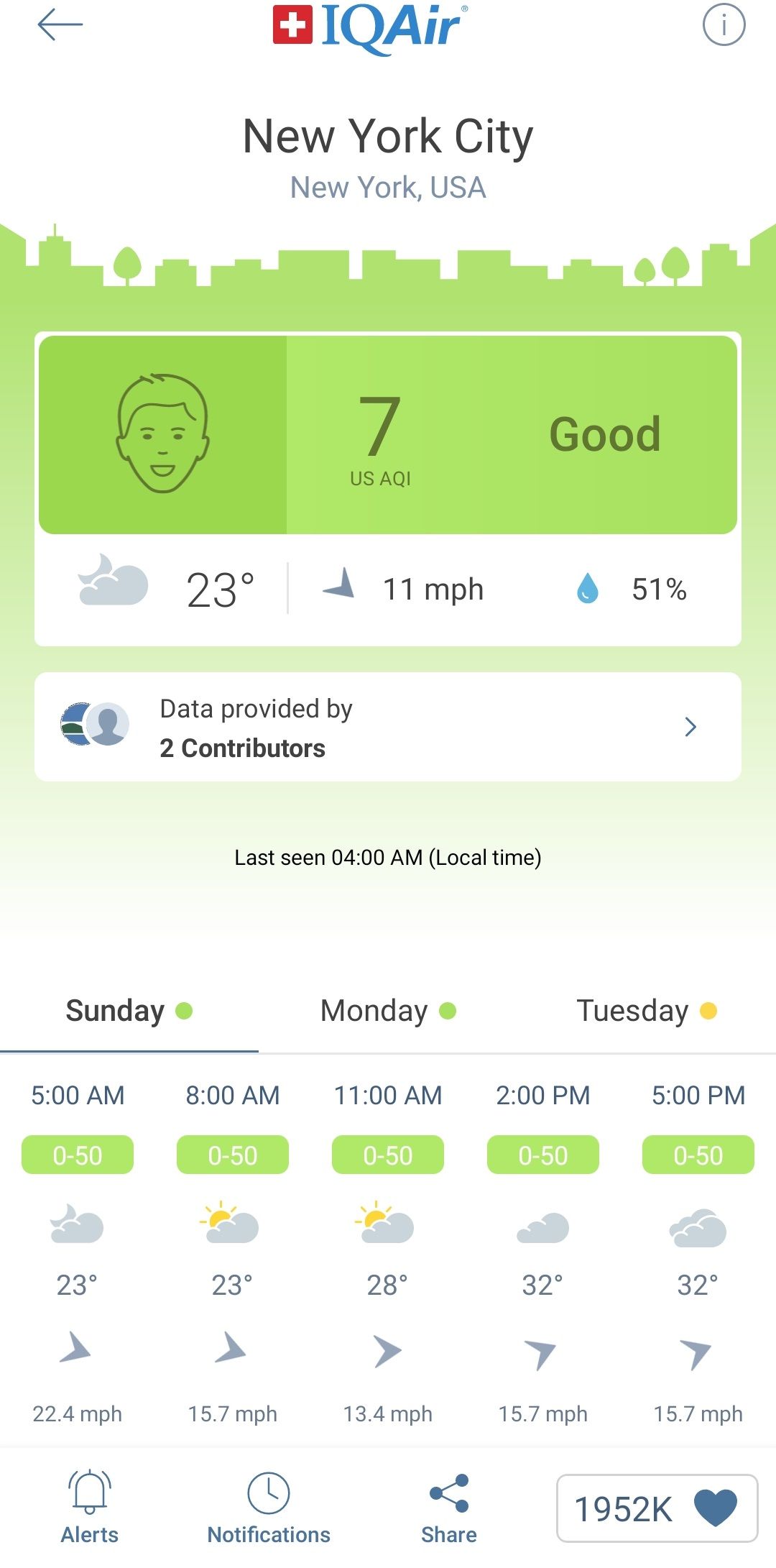
IQAir is a Swiss HVAC (Heating, Ventilation, and Air Conditioning) company. IQAir sells air purifiers, air quality monitors, and KN95 masks. AirVisual is their air quality information mobile app.
The AirVisual mobile app enables you to monitor the air quality of multiple cities (10,000+ cities in 80+ countries per Google Play Store listing). The data provided is compiled from contributors using air quality monitors.
It includes:
- current air quality and weather
- weather forecasts (precipitation, temperature, and wind)
- health recommendations (outdoor exercise, home ventilation, mask wearing, and running an air purifier)
- recent image of the locality or city
- breakdown of pollutants (PM2.5, PM10, O3, NO2, SO2, CO...)
- hourly and daily history of air quality in the locality or city
- map of the locality
A statistics tab approximates indoor and outdoor air quality in your neighborhood as well as the number of polluted hours out of 24 hours that day.
A news and ranking tab shows cities air quality around the world from most polluted to least as well as news and resources about air pollution.
A shop tab allows you to purchase IQAir products such as their air quality monitor which you can link to the app and become a contributor to the air quality data in your area (with an IQAir account).
The United States or Chinese Air Quality Indexes (AQI) can be selected in Settings. IQAir explains the difference between these two indexes is explained here (What is the difference between China & US AQI; 美国空气质量指数和中国空气质量指数有什么区别?)
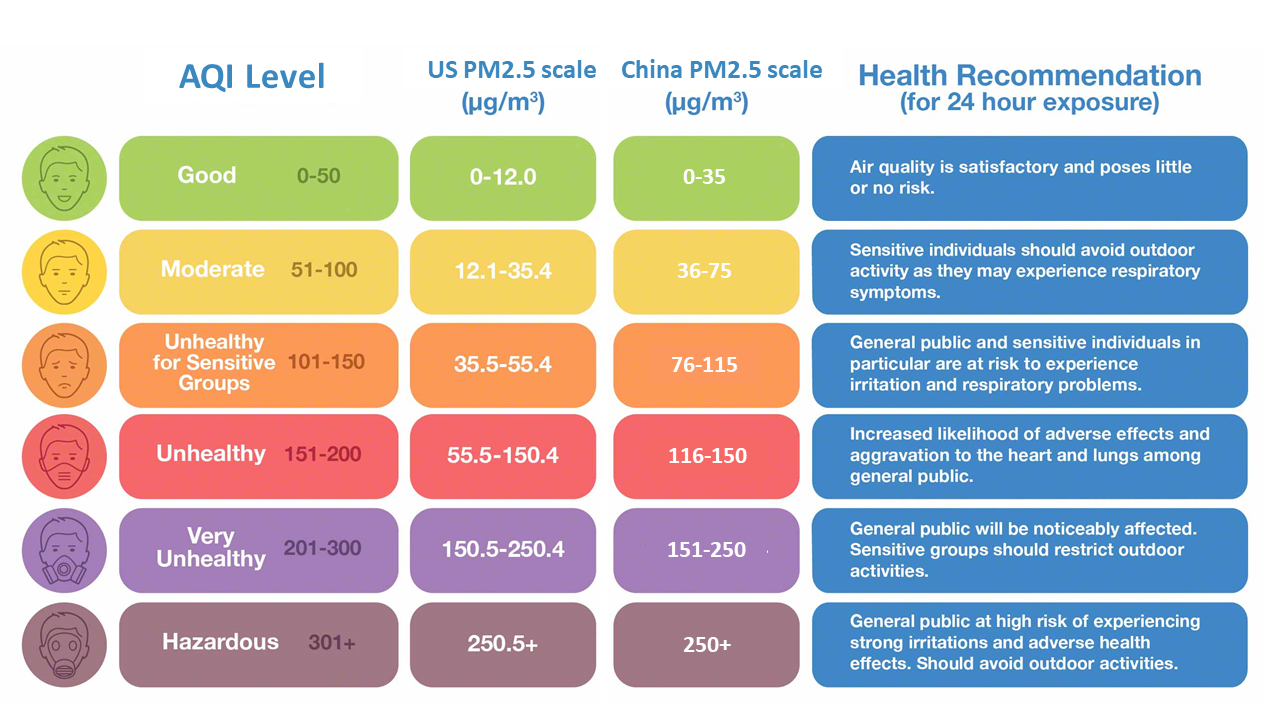
Air Matters App
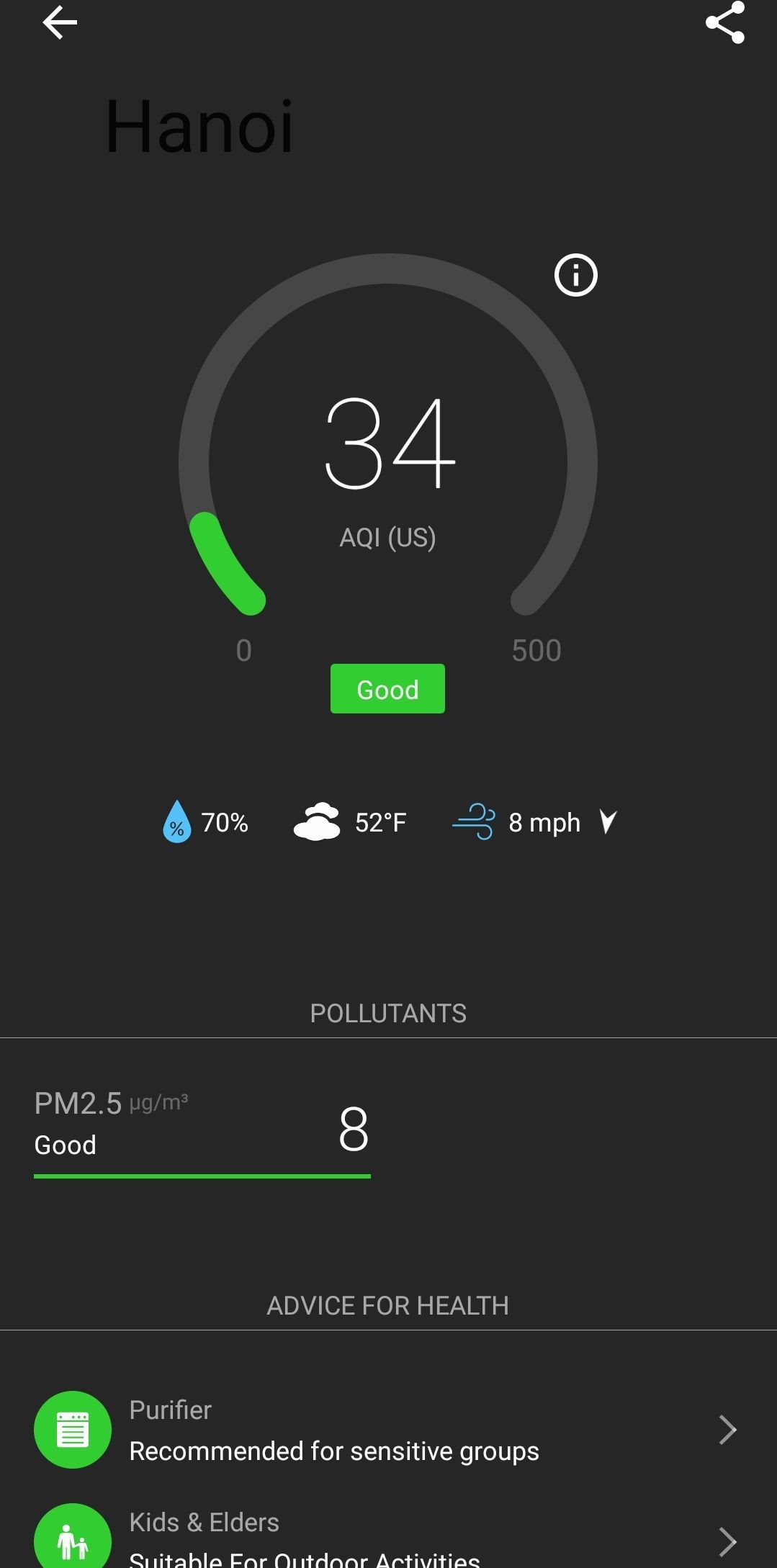
Air Matters (originally named China Air Quality Index) is a Chinese air quality information mobile app company.
The Air Matters mobile app also provides local air quality for multiple locations. Like AirVisual, you can link an air purifier or air monitor, however, unlike AirVisual, AirMatters has multiple choices of purifier/monitor brand.
It includes:
- current air quality and weather
- weather forecasts (precipitation, temperature, and wind)
- breakdown of pollutants & irritants (pollen, PM2.5, PM10, O3, NO2, SO2, CO...)
- advice for health (purifier use, kids & elders, home ventilation, mask wearing, and outdoor exercise)
- hourly and daily history of air quality in the locality or city
- map of the locality
An air quality map and air quality rankings list is available in the main menu.
Windy.com App
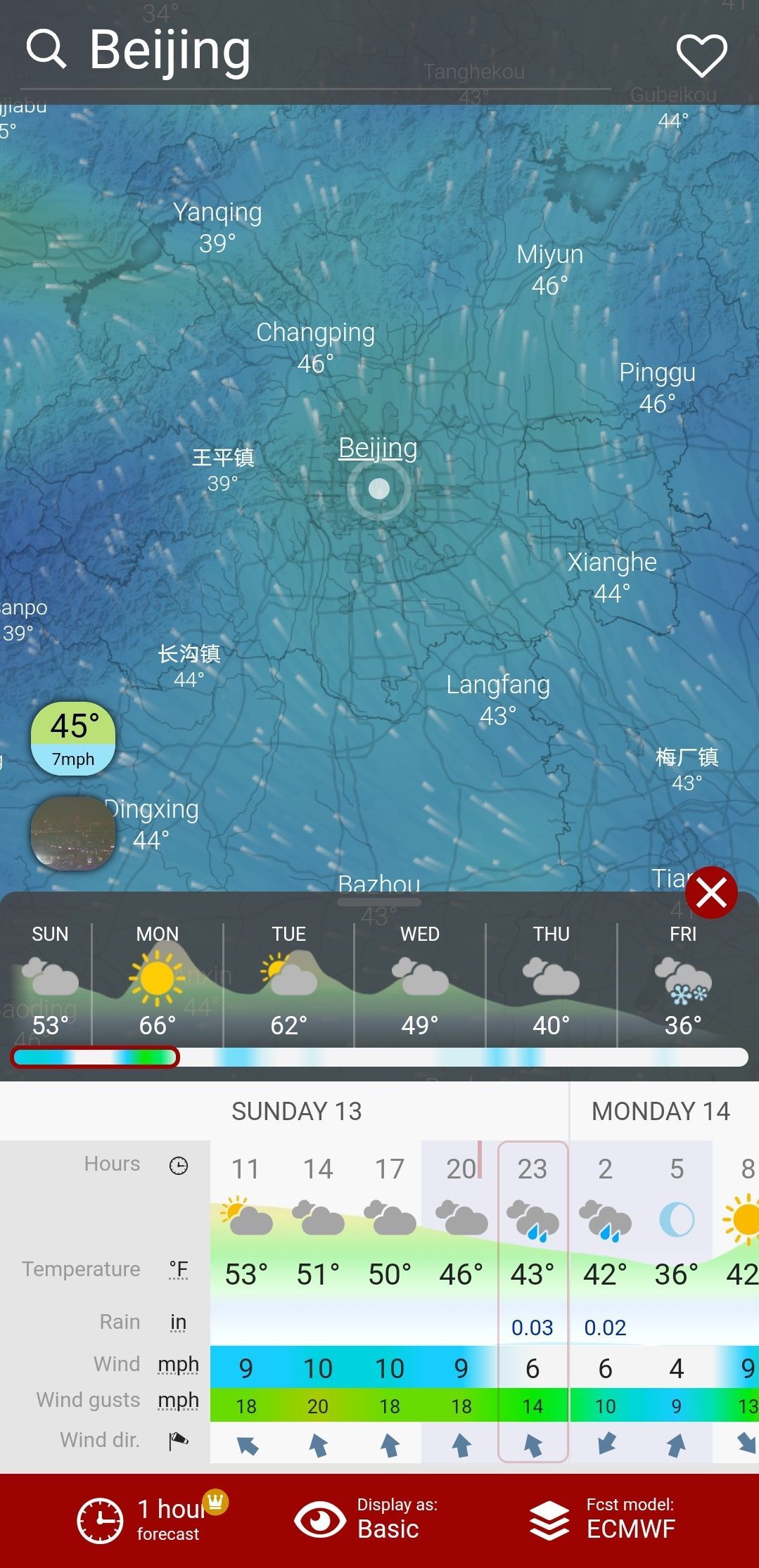
Windy.com (originally Windyty) is a Czech weather forecasting company and their app tracks and animates wind patterns as well as other weather related categories.
It includes:
- wind
- radar & satellite
- rain, thunder
- temperature
- clouds
- waves
- air quality
- and many more categories...
When air pollution is produced nearby and there is little to no wind movement, poor air quality accumulates in volume and worsens. The air simply sits there.
However when it is windy, polluted air is blown away. All air pollutants can be easily carried over great distances on the wind.
Windy’s focus on current and forecast wind gusts and speeds helps you track when increased wind will dissipate polluted air or blow polluted air in from elsewhere.
AccuWeather App
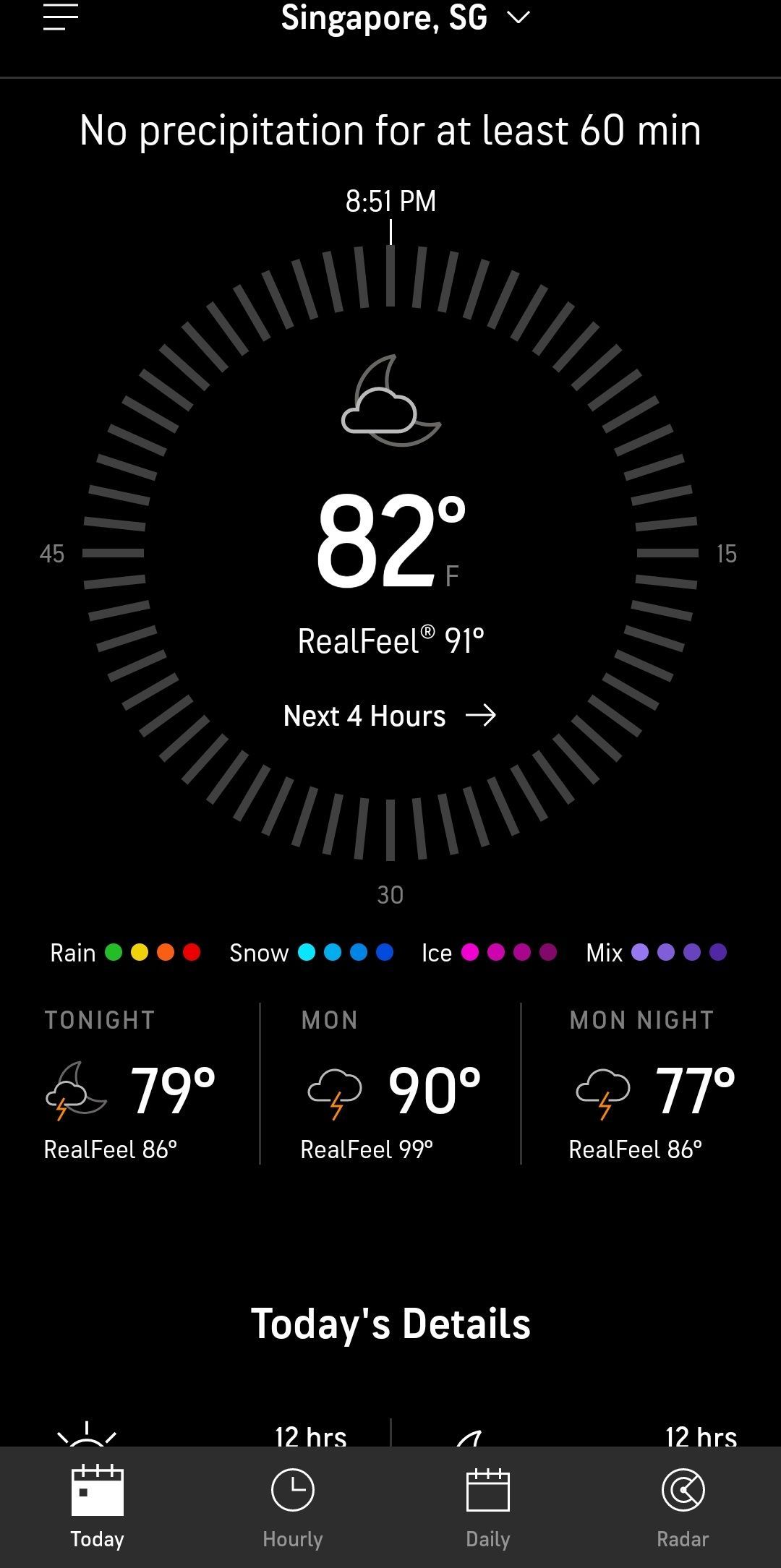
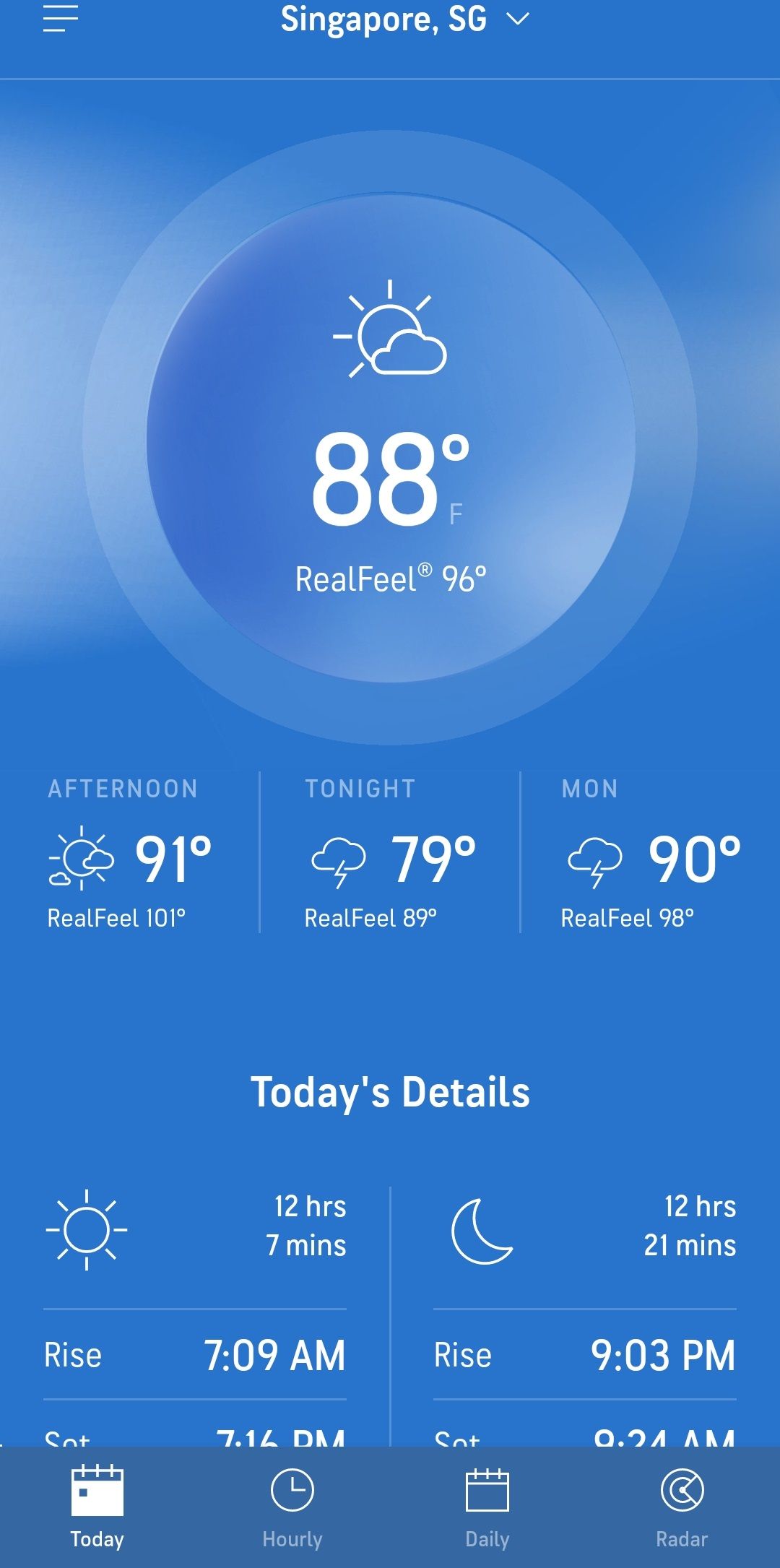
AccuWeather is an American weather forecasting company and its namesake mobile app provides weather forecasts.
AccuWeather’s primary function is monitoring weather in multiple locations but the app also includes an Allergy Outlook section and a Current Air Quality section with Air Quality Report that is currently sourced from French air quality information company Plume Labs, acquired by AccuWeather in January 2022. AccuWeather is also the source used in native weather apps on many mobile phones.
The Air Quality Report and Allergy Outlook includes:
- breakdown of pollutants (PM2.5, PM10, O3, NO2, SO2, CO...)
- air quality scale rating (excellent, fair, poor, unhealthy, very unhealthy, dangerous)
- dust and dander index (current and forecast)
Air Quality Websites
Air quality may also be checked through various websites, some of which are provided by some of the makers of the mobile apps mentioned above.
Air Quality websites include:
- airvisual.com by IQAir (now re-directs to iqair.com; while iqair.com/earth has replaced airvisual.com)
- air-quality.com by Air Matters
- windy.com
- waqi.info from the World Air Quality Index project
- aqicn.org from the World Air Quality Index project
- airnow.gov from partnership of U.S. agencies and departments (international current and historical air quality data has moved: https://www.airnow.gov/international/us-embassies-and-consulates)

Traveling is a joy. However, that joy can be soured if you are unable to breathe in a new country. With so many pollutants that can cause anywhere from minor discomfort to major health emergency, it is important to protect yourself. Wearing face masks, using air purifiers, staying in less polluted locations, and using monitoring technology to keep yourself informed can help remove the anxiety around breathing abroad and bring the joy back into traveling!
In upcoming posts, I'll share exactly which masks and air purifiers we use to protect ourselves while abroad. Sign up for our newsletter and become a member for blog updates!


